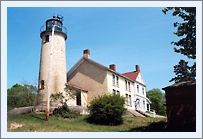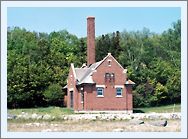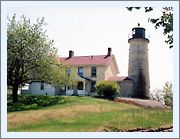 |
 |
 |
| Click to view enlarged images | ||
| Beaver Head Lighthouse | Seeing The Light |
|
|
|
|
Historical
Information
At this time, responsibility for the nation's aids to navigation fell under the auspices of Stephen Pleasonton, who was serving as the Fifth Auditor of the Treasury. Under funded and understaffed, the tight-fisted Pleasonton was forced to delegate the hands-on administration of lighthouses to the local Collectors of Customs. As collector of Customs for the Mackinac district, Charles A. Avery was instructed to select an appropriate location for the new station. Avery's representative selected a 158-acre tract of land on a bluff at the south end of the island known as "Cheyenne Point," and after it was determined that the parcel was already in Federal ownership, President Millard Fillmore signed an executive order reserving the land for lighthouse purposes on November 21, 1850. Avery advertised for bids for construction of the station immediately, and after his bid of $4,480 was determined to be the lowest submitted, Detroit contractor John McReynolds was awarded the contract for the stations construction in March 1851. Pans for the new station specified the erection of a brick tower capped with an octagonal iron lantern attached to a 26-foot by 30-foot dwelling attached to the tower by a covered passageway. On completion, the tower stood 46 feet from grade level to ventilator ball, and was outfitted with an array of fourteen Lewis lamps with reflectors situated at a focal plane of 103 feet, by virtue of the tower's location atop the bluff. Work on the station was completed in early winter, and the light exhibited for the first time late in the 1851 season of navigation.
Life at the station settled into a relatively quiet routine over the following ten years, with only routine maintenance and repairs conducted. Concern about the leaking cistern in the basement was voiced by the keepers for a number of years, but the complaints were ignored until after forest fires at the south end of the island in 1868 almost consumed the station buildings for a lack of an adequate water supply. Perhaps one of the most interesting Keepers assigned to the station was Harrison "Tip" Miller, who was appointed Keeper in 1863. Miller's father had been an early follower of Brigham Young, and the young "Tip" was baptized through a hole cut through the ice in Nuavoo, Illinois, then the home of the Mormon Church. The senior Miller followed Young west where he became disenchanted with Young's teachings. Discovering truth in the words of Prophet Strang, Miller again moved his family to Beaver Island to be closer to Strang. Fortunately away from the island when Strang was assassinated and his followers routed from the island by Archibald Newton, the Millers returned to their island home after things on Beaver Island calmed. Tip Miller and his Irish wife raised ten children at the Beaver Island lighthouse, and it would appear that he was quite an entrepreneur, enhancing his lighthouse service income serving as a fisherman, cooper and mail carrier during the winter months. Miller also had interests in patents for an ore lock and a hame fastener, in pursuit of which he traveled to Buffalo on a number of occasions to conduct patent-related business.
During the particularly harsh winter of 1885-1886, ice on the lake shifted the boat landing a distance from its location, requiring a work crew to be dispatched to move it back to its original location. To help prevent a reoccurrence, the crew lengthened the landing by 50 feet through the installation of a 10 foot by 18 foot stone-filled timber crib its outer end. A nasty storm the following November completely obliterated the boat house and ways, and a crew returned in 1887 to replace both structures, and erected a second timber crib offshore in front of the boathouse to help protect the structure from the violent waves. After dropping from sight for two years, 1876 was also the year in which Tip Miller resurfaced as the first Keeper at the newly established Beaver Harbor Life Saving Station, in which capacity Miller lead his valiant crew of surfmen on a number of renowned rescues before being transferred to the Point Betsie Life Saving station in 1887. With an increasing volume of maritime traffic making its way between Beaver and North Fox islands, the Lighthouse Board recommended the establishment of a fog signal station at Beaver Island in its 188 annual report. Congress evidently concurred with the importance of such an installation, since $5,500 was appropriated for the project as part of the sundry civil act of March 2, 1889. A survey was taken on the island that summer, and a site on a small plateau 30 feet above the lake and approximately 650 feet to the west of the lighthouse selected for the new structure. With the selected site being outside of the original reservation, negotiations were immediately begin for the purchase of an additional 10 acres of land, and by June 30, the Board's offer had been accepted and title papers were awaiting the owners signature.
After the establishment of the fog signal, it became clear that the workload was more than two keepers could cover, and the decision was made to add a Second Assistant at the station in 1898. However, with the duplex dwelling already representing tight quarters for two keepers, incorporating a third keeper into the dwelling made for less than desirable living arrangements. To solve the problem, District Engineer Milton B. Adams approved plans for the enlargement and modification of the dwelling, and a construction crew was dispatched to Beaver Island in 1902 to erect a large addition on the east end of the dwelling, and to modify the interior layout into three distinct apartments. While on site, the crew erected a red brick oil storage building, enlarged the boathouse, leveled and repaired the boat landing cribs, and installed 250 feet of plank walkways.
After 25 years exposure to the elements, the fog signal building was showing significant signs of deterioration, and plans were underway to replace the aging building with more durable structure. A work crew and materials arrived at the station in 1915 and erected a twenty-two foot wide by forty-foot long brick structure on the beach at the foot of the bluff in front of the old signal location. After the boilers and sirens were transferred and plumbed, the old structure was demolished. The illuminating apparatus was upgraded to an incandescent oil vapor system in 1917, with an increase in intensity of the fixed light to 1,700 candlepower and the white flash to 14,000 candlepower. With this installation, the characteristic of the light was also changed to show a fixed white light with a single 1.3 second flash every 20 seconds.
Two years after Miller's death, the fog signal at the Beaver Island light was upgraded to an air "Tyfon" powered by a diesel engine-powered air compressor. With the introduction of electric power to the station in 1938, the incandescent oil vapor lamp was replaced by an electric arc lamp. Responsibility for the nation's aids to navigation was transferred to the Coast Guard in 1939, and with that change, crews of seamen were assigned to work with the keepers at the station. As part of this responsibility reassignment, the Civilian keepers were given the option of either incorporating into the Coast Guard at a relative rating, or maintaining their civilian status. Evidently all three of the civilian keepers assigned to Beaver Island were less than enamored with the opportunities represented by incorporation into the Coast Guard, as they all resigned from service within a year of the take over.
With the establishment of an automatic radio beacon tower to the east of the station in 1962, the Beaver Island light station had outlived its usefulness. The seamen assigned to the station were transferred to alternate assignments and the buildings boarded up and abandoned. At some time thereafter, the lighthouse was transferred into private ownership, and served as a hunting club for a number of years. However, without the constant attention of a team of dedicated keepers, the condition of the station buildings deteriorated, and the lighthouse suffered the ravages of mindless vandals who ravaged the interior rooms, broke out windows and doors, and even went so far as to pepper the interior walls with rifle fire.
Exposed as it is to the elements, the
brick fog signal building was showing significant spalling at the turn
of the twenty-first century, and a grant was obtained to restore the
structure in 2003. From the St' James dock at which the
ferry lands, you will need to enquire about renting a car or motor
scooter for the 40 minute drive to the south end of the island where the
Beaver Island Lighthouse is located. |